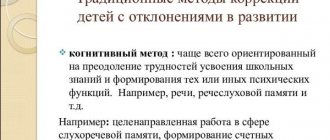To date, the speech activity of children with mental retardation has not been studied enough. The main researchers in this area are N. Yu. Boryakova, L. V. Yassman, R. I. Lalaeva, E. V. Maltseva, R. D. Triger. Scientists have found that children with mental retardation have various disorders of oral and written speech, associated, first of all, with a violation of their cognitive activity.
The works of various authors attempt to classify children with mental retardation, taking into account the nature of their speech disorders. So E.V. Maltseva identifies three groups.
The first group consists of children with an isolated defect, manifested in the incorrect pronunciation of only one group of sounds. Disturbances in these children are associated with an anomaly in the structure of the articulatory apparatus and underdevelopment of speech motor skills.
The second group is children who have been identified with phonetic-phonemic disorders. Sound pronunciation defects in this group cover 2-3 phonetic groups and manifest themselves mainly in substitutions of phonetically similar sounds.
The third group is children with systemic underdevelopment of all aspects of speech. In addition to phonetic and phonemic disorders, significant disturbances in the development of the lexical and grammatical aspects of speech are observed.
Not all children in this category have problems with the pronunciation of sounds. The most common distortion of sonorant sounds, sigmatism (usually interdental pronunciation of the sounds S, Z, C).
Some children may retain manifestations of infantile speech such as mild physiological tongue-tiedness.
Producing sounds in children at risk does not cause any particular difficulties, while automation and differentiation require long-term and systematic work.
Underdevelopment of the phonemic aspect of speech in children with mental retardation is manifested in insufficiently clear discrimination of acoustically similar sounds, significant difficulties in determining the number and sequence of sounds in a word, and impaired discrimination of the concepts “sound,” “letter,” and “syllable.” Schoolchildren make mistakes when dividing words into syllables.
Due to the underdevelopment of phonemic processes in this category of children, the development of sound analysis skills is delayed. As a rule, only the easiest type of sound analysis is available to them: isolating the sound from a word if the sound is under stress.
Children have a poor vocabulary , a predominance of a passive vocabulary over an active one, inaccuracy in the use of words, an unformed meaning of a word, and an insufficiently developed dictionary of antonyms and synonyms.
Schoolchildren speak an insufficient number of generalizing words. When generalizing, children get confused into groupings based on situation, external similarity, and non-existent characteristics. They do not use generally accepted words, but their own inaccurate or incorrect generalizations. This is explained by the peculiarities of their thinking (it is concrete).
A large number of primary schoolchildren with mental retardation have significant underdevelopment of inflection, word formation, and syntactic sentence structure.
Children observe incorrect use of case endings of nouns in indirect singular and plural cases; violation of the agreement of nouns with adjectives, numerals, pronouns in gender and case.
A particularly large number of errors are noted in the use of prepositions, both simple and complex.
The process of word formation in children of this category is delayed and drawn out over time. “Children’s word creation” is found even in the speech of 4th grade students. As a rule, several word-formation variants are observed in the speech of children with mental retardation.
Students show violations of sentence structure and grammatical design of sentences. Children use mainly simple common sentences.
Schoolchildren have a low level of proficiency in monologue speech; its meaning is understandable only in a certain situation. Children at risk experience great difficulty in independently retelling a text, composing a story based on a picture, or describing an object. They usually list what is shown in the picture, making many grammatical errors.
The main stages of generating a speech utterance are not sufficiently formed in children intention, internal programming, grammatical design.
Thus, summarizing the data on the state of oral speech in children with mental retardation, we can conclude that their speech disorders cover many aspects of speech activity. Taken together, these disorders create serious obstacles in teaching children to write and read correctly.
Difficulties in developing writing can be observed in students with mental retardation throughout the entire period of study. They turn out to be untenable when writing auditory dictations. The following errors occur in dictations:
- missing letters;
- rearrangements of letters and syllables;
— insertion of extra letters;
- replacement and mixing of letters, syllables;
- continuous spelling of words.
Children do not know how to indicate sentence boundaries in writing using capital letters and periods; make mistakes in spelling prefixes and prepositions.
These types of errors occur at the initial stages of learning in the work of all children, but in case of difficulties these errors become persistent. Students experience specific difficulties in writing and reading ( dysgraphia, dyslexia ), which lead to persistent problems in mastering knowledge not only in the Russian language and reading, but also in other academic subjects.
The content of speech therapy work is closely related to the literacy program for children with mental retardation.
In the process of speech therapy work:
— correction of violations of oral and written speech is carried out,
- correct speech skills are consolidated,
— the practical level of language acquisition is formed.
The entire process of speech therapy work is aimed at the development and formation of cognitive processes in children.
The work uses games and game exercises , which allow game motivation to gradually transform into educational motivation.
In the process of work, a fairly large amount of visual material , with the maximum connection of all safe analyzers.
Diagrams, speech sound profiles, split alphabet, cards, gaming exercises and games, and technical teaching aids are used.
Work on developing the correct pronunciation of sounds and the development of phonemic perception is carried out in parallel. Modeling of the sound composition of a word is introduced, and tasks for the formation of sound analysis are included.
All this big work is carried out in stages, from simple to complex. Schoolchildren with mental retardation should not be given multi-step instructions; it is better to give them in the right sequence, gradually making the task more difficult.
Considering the close connection between manual and articulatory motor skills, speech therapy classes include exercises for the development of fine hand movements and elements of speech therapy rhythm.
Due to the rapid fatigue of children, elements of health-saving technologies are being introduced into classes.
Thus, work on speech correction in children with mental retardation is carried out taking into account the violation of all components of speech and is inextricably linked with the development of mental processes.
Individual developmental characteristics or delay?
In order not to make a mistake in making a diagnosis, you need to know where there is an individual developmental feature and where we are talking about a lag. Each baby develops at its own pace, so developmental standards are quite flexible. For example, the norm for a one-year-old child is to pronounce 10 words, but this does not mean that if your child speaks only 7, then he should already be diagnosed with delayed speech development. This is even influenced by gender: it’s no secret that boys are always a little behind girls in development. This can be explained simply if you look into physiology. Speech can be adequately formed with the coordinated work of both hemispheres, which are connected to each other by a bundle of nerve fibers - the corpus callosum. In boys, this bundle is much thinner, therefore the connection between the hemispheres develops more slowly, which leads to later development of speech. It is simply more difficult for boys to transform their thoughts into words, but this does not mean that they do not understand. If there are no pathologies in the development of brain structures or mental abnormalities, then over time everything will return to normal, and the future man will speak no worse than the girls. But mothers of boys should not let the situation take its course, especially if there is a strong lag, because among boys the percentage of ZPRR is quite high. Many mothers are interested in what time do children start talking when they have ZPRD? Only one thing can be said: if up to 2.5 years old “baby” speech and incomplete pronunciation of words are considered the norm, then after this age the child must put words into simple sentences. If there are no such attempts, then you should sound the alarm and contact specialists. For parents, it is not at all clear what to do if a diagnosis of SPR is made, but, first of all, there is no need to panic. Therapy started on time gives good results.
What are the main causes of delayed speech and mental development?
Delayed speech and psycho-speech development are not independent diseases, but consequences of deviations in the development of the brain and central nervous system.
Factors provoking ZPRD:
- Mother's illnesses during pregnancy. Impaired fetal development can be caused by infection, poisoning, or injury.
- Oxygen starvation (hypoxia) of the fetus in the womb.
- Difficult birth (rapid, premature, entanglement of the umbilical cord around the neck), trauma to the child during childbirth (perinatal encephalopathy, injury to the central nervous system, cervical spine).
- The child has suffered severe infections (causing brain diseases) and injuries at an early age.
- Genetic, chromosomal diseases in which the structure of the brain is disrupted.
- Incorrect upbringing: the child grows up under too much care or, on the contrary, is abandoned to the mercy of fate, the child is abused at home. More often, children with mental retardation disorders come from asocial families.
- Severe mental trauma at an early age.
Diseases that can cause delayed psycho-speech development:
- congenital anomalies of the central nervous system and metabolic disorders in it;
- epilepsy and other mental illnesses;
- cerebral ischemia;
- hydrocephalus;
- increased intracranial pressure;
- cerebral palsy;
- a brain tumor;
- pathologies of cerebral vessels;
- leukodystrophy;
- violation of liquor dynamics.
Let us emphasize once again that delayed speech and mental development occurs due to disruption of brain function (under the influence of birth injuries, infections), the presence of certain hereditary diseases (ZPRD worsens in each subsequent generation), and the unfavorable psychological climate in which the child grows up. So it is necessary to treat not only PVRD, but also the reasons for its appearance in the first place.
conclusions
Don't ignore early signs that your child is having difficulty understanding or producing speech. Attention is paid not only to the correctness of sounds, but also to the logic of the narrative, speed and compliance of the level of speech with standards at a certain age.
Defects are easier to fix when they are not running. This is done both with the help of specialists and at home, because the process of learning and correction is a game and live communication. If you have patience and desire, every adult can work with a child.
Work should be based on games and regular repetition of even the smallest details. The process of cognition and learning should not end, because it is multi-stage. There will always be areas where you can improve or make the task more difficult. During classes, the child should feel comfortable, the material should arouse his interest, but not negative emotions.
Diagnosis of mental retardation and methods of correction
To diagnose mental retardation in a child, it is necessary to consult several specialists who can confirm or refute this condition. This is a speech therapist, defectologist, psychologist, neurologist, pediatrician, and also a psychiatrist.
To diagnose CPR, the following is necessary:
- Detailed history taking.
- Carrying out CT, MRI, as well as an encephalogram, the results of which may indicate the presence of physiological reasons for the possible development of mental retardation.
- Conducting a psychological and pedagogical examination, during which the child’s ability to think and play activities is established. A diagnosis of memory, attention, as well as the emotional-volitional sphere of the child is carried out.
- Detailed examination of speech features.
If, as a result of studies, diagnostics, and consultations, this condition is confirmed, the baby needs corrective measures. Treatment is complex and requires the involvement of a whole group of different specialists. In the learning process, an emphasis on repetition, frequent changes of activities, and visualization of educational materials is important.
What is important to pay special attention to in the process of correctional work:
- An increase in the number of cognitive processes.
- The emotional sphere of the child, which is normalized as a result of active activities in a playful way.
- Normalization of speech activity, which is possible during regular speech therapy classes.










